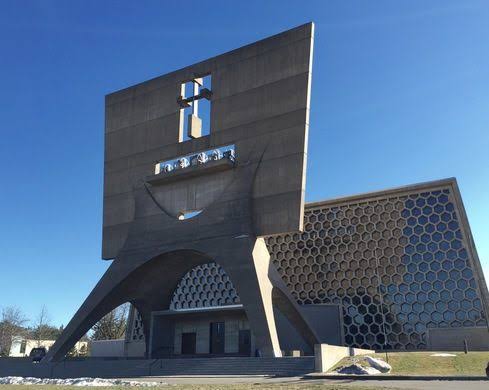Monuments of architecture and creators of the transcendence: Marcel Breuer (part 3)
(Image from the public domain)
What is brutalism architecture? As form or a purpose of design. The very name evokes a harshness, the brutal and starkness of reinforced concrete. First used by Reyner Banham as an architectural critic to describe the masses of concrete inspired structure built in earnest from the late 1940s right through to the mid 1970s. More so, its name was somewhat a derivative of the early 1900s art movement known as beton brut (raw art). But, the correlation between beton brut art and brutalist architecture is tentative at best. And it was architects such as Marcel Breuer who crafted concrete in way he would craft metal or wood. That's what made his innovation within brutalist architecture as one the greats of that architectural movement. Because of his roots as a furniture designer and the ability to manipulate form, making it comfortable, functional and unique – to which he also applied to these so called Brutalist buildings.
Leaving Germany in 1936, to live and work in England, where he continued to design furniture and leaned from the famous English modernist architect F.R.S (Francis Reginald Stevens) Yorke. Breuer was offered a teaching position at Havard's Graduate School of Design. Breuer now in America, begins to imprint his vision of architecture, now inside, figuratively speaking, within the structure of a building industry with already several small projects already completed. It doesn't take long for Breuer to begin tendering for projects. After leaving Massachusetts and establishing his Architectural firm in New York City, which was perfectly timed in the mid to late 1940s, where the creative destruction and rebuilding of that city was at a constant pace. Breuer continues with the modernist structures as his forte, melding ever closer to the main projects which he will be well known for the: UNNESCO building and Saint John's Abbey; it is by these circumstances of timing and fate as one of the most reputable architects of the brutalist era Le Corbusier, through controversy over Le Corbusier's original plans for the United Nations Headquarters in NYC – reworked by US State Department, which were altered significantly without the knowledge of the famed architect. Once aware, it began a media spectacle. Thus the US government, in a vindictive way, vetoed the contract between UNESCO planning committee and Le Corbusier. Essentially making the contract void. This in turn, allowed three international architects to commit to the project which included Breuer.
Leaving Germany in 1936, to live and work in England, where he continued to design furniture and leaned from the famous English modernist architect F.R.S (Francis Reginald Stevens) Yorke. Breuer was offered a teaching position at Havard's Graduate School of Design. Breuer now in America, begins to imprint his vision of architecture, now inside, figuratively speaking, within the structure of a building industry with already several small projects already completed. It doesn't take long for Breuer to begin tendering for projects. After leaving Massachusetts and establishing his Architectural firm in New York City, which was perfectly timed in the mid to late 1940s, where the creative destruction and rebuilding of that city was at a constant pace. Breuer continues with the modernist structures as his forte, melding ever closer to the main projects which he will be well known for the: UNNESCO building and Saint John's Abbey; it is by these circumstances of timing and fate as one of the most reputable architects of the brutalist era Le Corbusier, through controversy over Le Corbusier's original plans for the United Nations Headquarters in NYC – reworked by US State Department, which were altered significantly without the knowledge of the famed architect. Once aware, it began a media spectacle. Thus the US government, in a vindictive way, vetoed the contract between UNESCO planning committee and Le Corbusier. Essentially making the contract void. This in turn, allowed three international architects to commit to the project which included Breuer.
This is his turning point, from a small beginning as a furniture designer, teaching at Bauhaus, learning from F.R.S Yoke the modernist master, taking all that experience to America. The end of World War Two and the massive destruction of European cities and its rebuilding – with a Cold War beginning, the reaffirming of boarders between countries. Marcel Breuer designs one of the most stunning and transcending forms of brutalism. St John Abbey Church, Minnesota. And it is from that point Breuer is now mastering concrete, the encasement, the supporting structure that is seen not just as external force but also internal. Protective, safe, able to withstand both nature and man's destructiveness. Symbolic, with its sculptural inspired concrete shield, bearing the Christian cross. The structural inversion within the church, it becomes a safe haven from turmoil of world, hexagonal ornamented windows. It feels like it has been built from the inside out. Not only is the facade striking, it corresponds with the interior. As refuge from the wraith of the cosmos.


Comments
Post a Comment